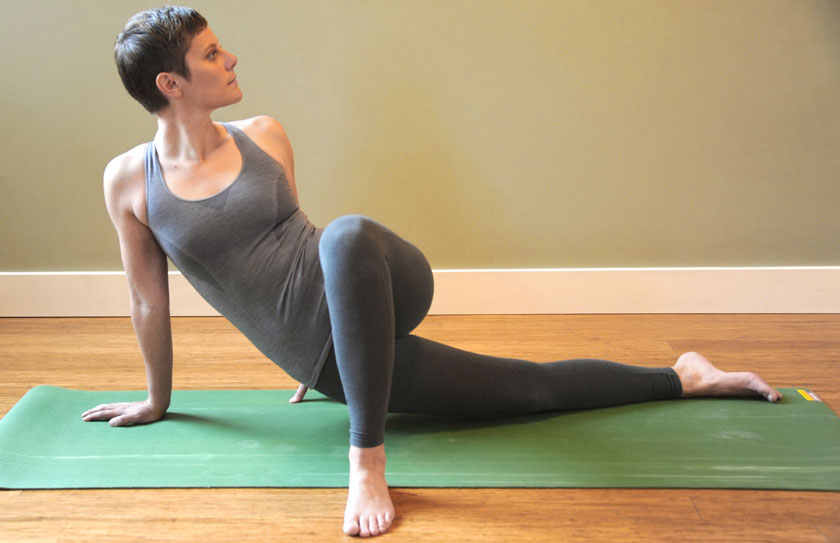
The pose Anjaneyasana (Lunge Pose), in all its variations, was named after a young legend named Anjaneya. Born to Anjana (a supernatural woman) and Kesari (king of the monkeys), Anjaneya had magical powers and royalty in his genetic inheritance. His godfather was Vayu, the wind god. Anjaneya was considered to be the reincarnation of Lord Shiva. His auspicious pedigree made him a bit of a star among mortals.
According to legend, Anjaneya once mistook the sun for a glowing piece of fruit. In an effort to grab it for himself, Anjaneya leapt repeatedly, much to the annoyance of Indra, the sun god. A battle ensued, causing Vayu, the wind god, to leave in a huff, jeopardizing life on Earth. Indra brokered a deal that gained Anjaneya his immortality and got Vayu back to work.
Anjaneyasana (Lunge Pose) expresses its namesake’s incessant leaps toward the sun. Parvrtta Anjaneyasana (Revolved Lunge) is a twisted version of Anjaneyasana. I learned this pose from my most influential asana teacher, Donna Farhi, who developed it years ago. She called it “Chaise Lounge Pose.”
Here’s what Donna has to say about the pose: “Revolved Lunge evolved out of felt sense
that the SIDES of my body were very tight. That was the beginning of a long exploration into the significance of the lateral line through the body and how side-bending and rotation opens and releases the spine at its deepest level (the intervertebral muscles).
“More specifically, the lateral lunge lengthens the quadratus lumborum (QL). When QL is tight on one side it can contribute to all kinds of sacroiliac and lumbar issues and I always suspect it as a culprit when people tell me they have chronic tension on one side of the lower back. Often this can be seen by viewing the contour of the waist on each side.”
Parvrtta Anjaneyasana Benefits
The benefits of practicing Parvrtta Anjaneyasana are many: It lengthens the muscles and fascia of the outer bottom leg; expands the heart and chest; and rotates the thoracic spine, an area that loves to twist but that we too often ignore, much to our detriment. As we age, our thoracic spines often become less mobile, causing shoulder and neck tension. Revolved Lunge is a strong twist that mobilizes the thoracic spine. Plus, it feels good; it’s a perennial crowd pleaser in my classes.
How to Practice
- Gather your props, a yoga mat and a yoga block.
- Begin in Tadasana (Mountain Pose), standing with your feet about hips-width apart. Bend forward from the hip joints into Uttanasana (Standing Forward Bend). Bend both knees and take a few deep breaths, inhaling into your back.
- Step your right leg back, straightening it at the knee so that you are in a high lunge with your left foot between your hands on the floor.
- After a few breaths lower your right knee to the floor. Turn your left foot outward 90 degrees and scoot it back a bit so that it lines up with your hipbones. Your foot should be at about a foot out in front of your pelvis.
- Press your right hand into the floor as you turn toward your left leg and extend your left arm up toward the sky. If you prefer, you can circle your left arm back behind you and place your hand on a yoga block or on the floor (as in the photo). Then press both hands downward to assist the rotation of your spine.
- Stay for 5 to 10 deep breaths, with your left arm either extended skyward or with your hand on the floor behind you.
- Untwist your body, returning to a lunge pose with your hands on the floor, on either side of your left foot.
- Step your right foot forward into Uttanasana. Take a few breaths here, checking in with what happened in Revolved Lunge. How has your forward bend changed? Do the two sides of your body feel different? Then step your left leg back and repeat on the other side.
There are two ways to practice Parvrtta Anjaneyasana. The first is what I described above, pressing hands into the floor to lift and turn the ribcage upward. This focuses on the spinal rotation. Another option is to let the torso hang so that it hovers just above the floor. This creates a strong lateral stretch in the torso.
If I only have time to practice a few poses, Parvrtta Anjaneyasana is one of them. It’s become a go-to for me because of the spinal rotation, and because it wakes up my shoulders and arms, and grounds and stretches my legs. If you practice vinyasa, play with adding this to your flow.
Updated article from July 9, 2014.
